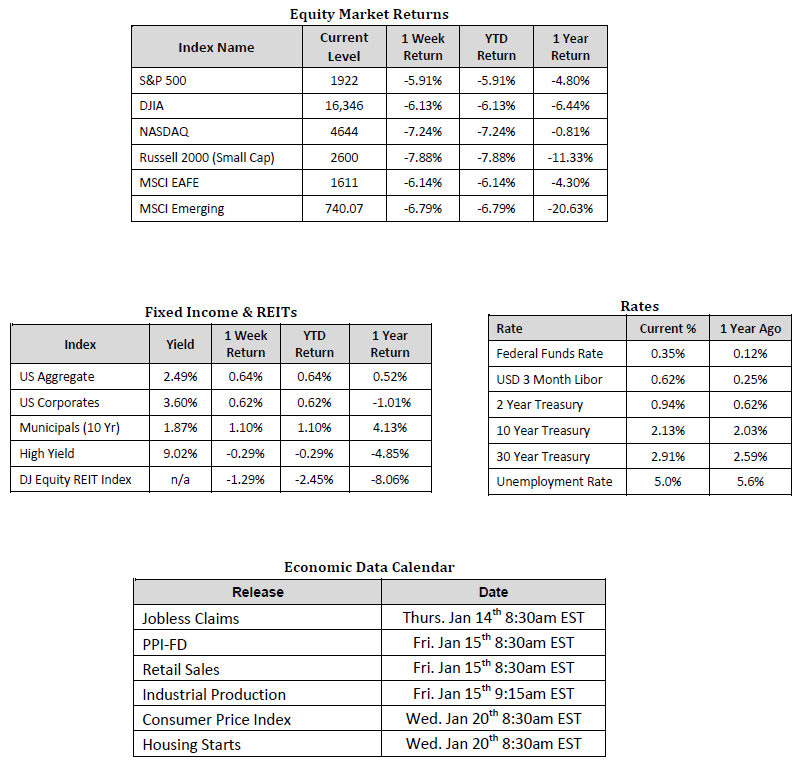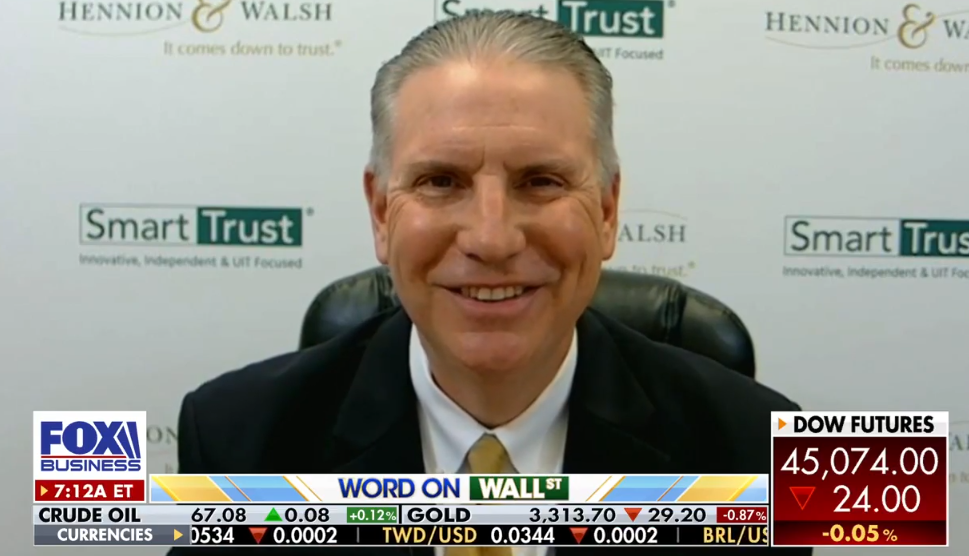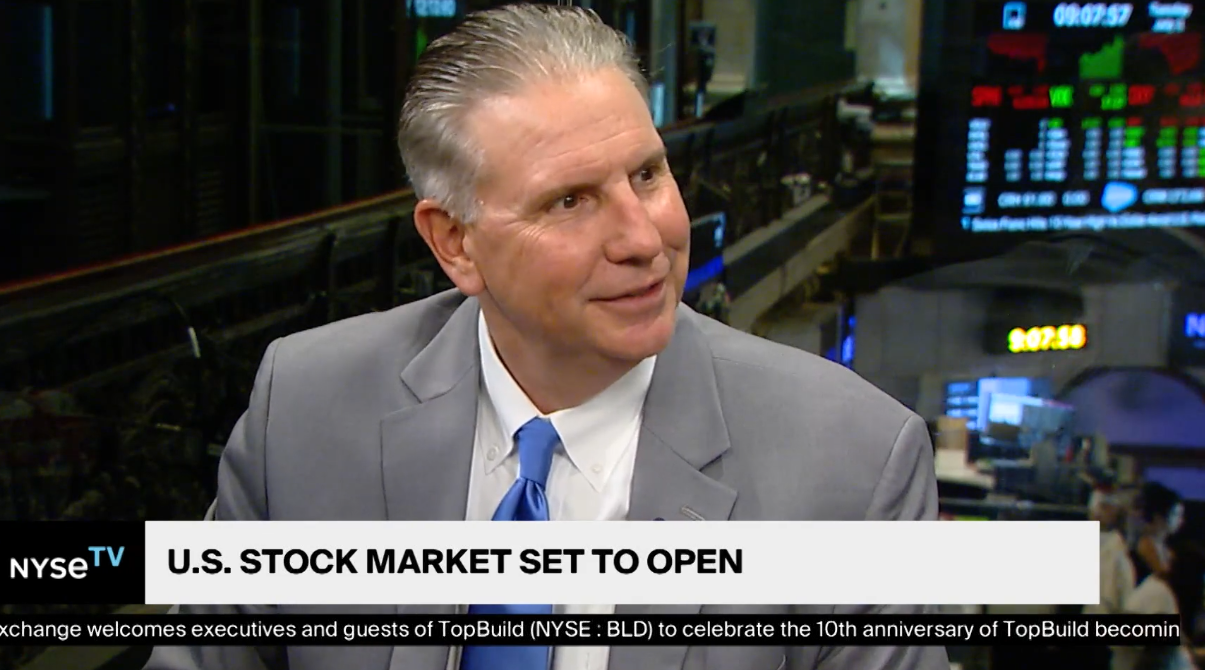
Lessons from Volatility
Market Overview

Sources: Equity Market, Fixed Income and REIT returns from JP Morgan as of 01/08/16. Rates and Economic Calendar Data from Bloomberg as of 01/11/16.
Happening Now
Stocks started off 2016 with their worst weekly performance since September of 2011. In fact, Monday January 4th through Friday January 8th, during which the S&P 500 Index dropped 5.9% and the Dow Jones Industrial Average fell 6.1%, will be remembered as the worst week to start a new year in the history of the U.S. Stock Market. As we discussed last week in our recent blog post, Putting China Into Perspective, newly implemented regulations in China were at least partly to blame for the selloff witnessed in equity markets around the globe. The question now turns to, “Where do we go from here?” and investors overly focused on media headlines may have a tough time coming up with an answer. We, at SmartTrust®, would suggest focusing on the longer term fundamentals that drive the economy, corporate earnings and stock market valuations while refraining from making short term changes.
It is well documented that trying to time the market is often an effort in futility. Consider that over the past 20 years of the S&P 500 Index, from January 1995 – December 2014, six of the 10 best days occurred within two weeks of the 10 worst days1. Moving all or a portion of an account built for long term growth to cash following periods of stock market volatility could potentially derail a well thought out financial plan. Over the 20 year period discussed above, investors who remained fully invested would have seen a $10,000 investment grow to over $65,400 while those who missed just the 30 best days would have only grown their initial sum to a little over $13,4002.
We believe that diversification should play a greater role in investor portfolios as the market shifts from the environment of double digit returns that characterized this historic bull market run to one of lower single digit returns and heightened volatility as we witnessed in 2015. In order to successfully build and manage a diversified portfolio, the key is to find the right blend of asset classes that can achieve a specific return over a long term time horizon while balancing risk.
1 Data from JP Morgan Asset Management.
2 Sample assumes an investment in the S&P 500 Index and does not consider commissions, trading costs or taxes. All data from JP Morgan Asset Management.
Important Information and Disclaimers
Disclosures: Hennion & Walsh is the sponsor of SmartTrust® Unit Investment Trusts (UITs). For more information on SmartTrust® UITs, please visit www.smarttrustuit.com. The overview above is for informational purposes and is not an offer to sell or a solicitation of an offer to buy any SmartTrust® UITs. Investors should consider the Trust’s investment objective, risks, charges and expenses carefully before investing. The prospectus contains this and other information relevant to an investment in the Trust and investors should read the prospectus carefully before they invest.
Investing in foreign securities presents certain risks not associated with domestic investments, such as currency fluctuation, political and economic instability, and different accounting standards. This may result in greater share price volatility. These risks are heightened in emerging markets.
There are special risks associated with an investment in real estate, including credit risk, interest rate fluctuations and the impact of varied economic conditions. Distributions from REIT investments are taxed at the owner’s tax bracket.
The prices of small company and mid cap stocks are generally more volatile than large company stocks. They often involve higher risks because smaller companies may lack the management expertise, financial resources, product diversification and competitive strengths to endure adverse economic conditions.
Investing in commodities is not suitable for all investors. Exposure to the commodities markets may subject an investment to greater share price volatility than an investment in traditional equity or debt securities. Investments in commodities may be affected by changes in overall market movements, commodity index volatility, changes in interest rates or factors affecting a particular industry or commodity.
Products that invest in commodities may employ more complex strategies which may expose investors to additional risks.
Investing in fixed income securities involves certain risks such as market risk if sold prior to maturity and credit risk especially if investing in high yield bonds, which have lower ratings and are subject to greater volatility. All fixed income investments may be worth less than original cost upon redemption or maturity. Bond Prices fluctuate inversely to changes in interest rates. Therefore, a general rise in interest rates can result in the decline of the value of your investment.
Definitions
MSCI- EAFE: The Morgan Stanley Capital International Europe, Australasia and Far East Index, a free float-adjusted market capitalization index that is designed to measure developed-market equity performance, excluding the United States and Canada.
MSCI-Emerging Markets: The Morgan Stanley Capital International Emerging Market Index, is a free float-adjusted market capitalization index that is designed to measure the performance of global emerging markets of about 25 emerging economies.
Russell 3000: The Russell 3000 measures the performance of the 3000 largest US companies based on total market capitalization and represents about 98% of the investible US Equity market.
ML BOFA US Corp Mstr [Merill Lynch US Corporate Master]: The Merrill Lynch Corporate Master Market Index is a statistical composite tracking the performance of the entire US corporate bond market over time.
ML Muni Master [Merill Lynch US Corporate Master]: The Merrill Lynch Municipal Bond Master Index is a broad measure of the municipal fixed income market.
Investors cannot directly purchase any index.
LIBOR, London Interbank Offered Rate, is the rate of interest at which banks offer to lend money to one another in the wholesale money markets in London.
The Dow Jones Industrial Average is an unweighted index of 30 “blue-chip” industrial U.S. stocks.
The S&P Midcap 400 Index is a capitalization-weighted index measuring the performance of the mid-range sector of the U.S. stock market, and represents approximately 7% of the total market value of U.S. equities. Companies in the Index fall between S&P 500 Index and the S&P SmallCap 600 Index in size: between $1-4 billion.
DJ Equity REIT Index represents all publicly traded real estate investment trusts in the Dow Jones U.S. stock universe classified as Equity REITs according to the S&P Dow Jones Indices REIT Industry Classification Hierarchy. These companies are REITSs that primarily own and operate income-producing real estate.



